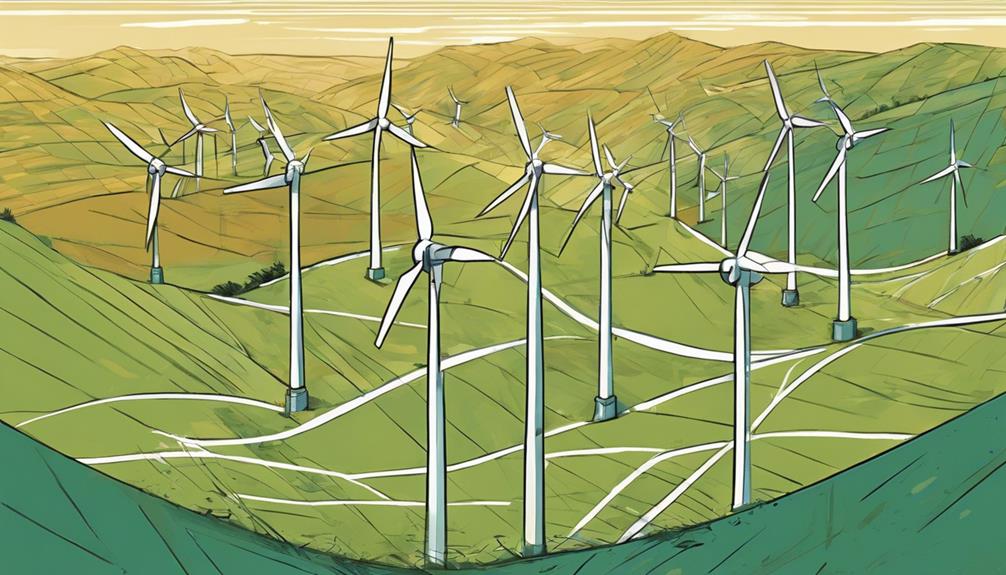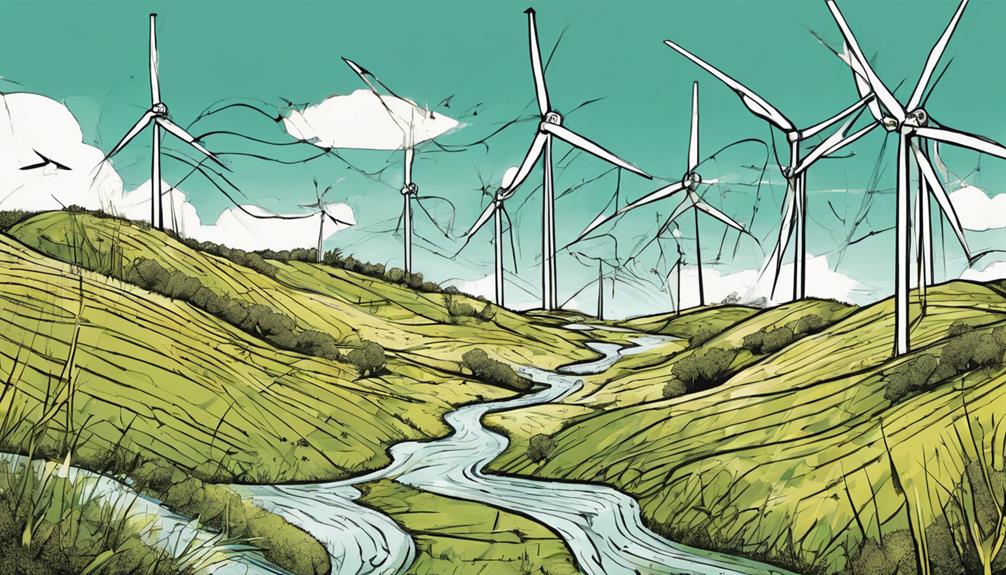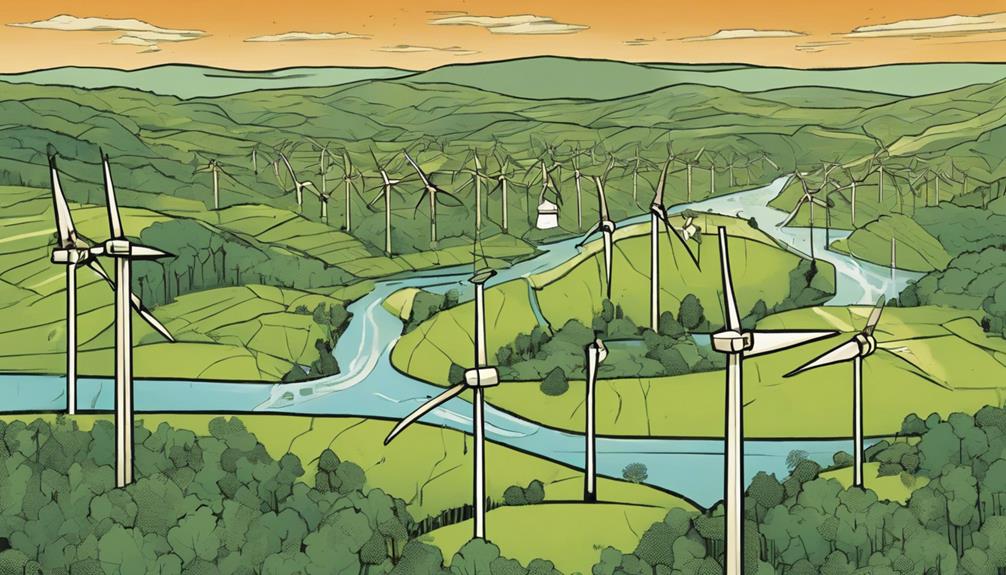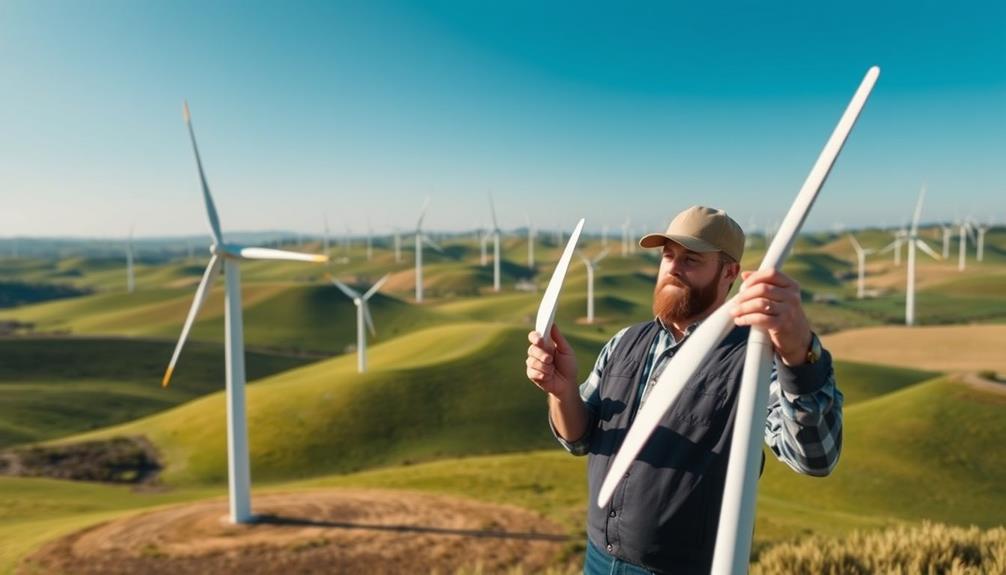To maximize wind power, strategic turbine positioning is key. Active yaw control, wake modeling, and cost-benefit analysis are essential strategies. Proper orientation influences power forecasting, rotor design, and structural loads. Factors like wind direction, terrain, and obstructions must be considered. Benefits include increased energy production, longer lifespan, and cost savings. Site selection is also vital, with 80% of energy output depending on it. Regular maintenance is necessary to ensure safety and efficiency. By optimizing turbine positioning, energy output can increase by up to 10%. Now, discover how to realize the full potential of wind power.
Key Takeaways
- Proper turbine alignment considers prevailing wind direction, terrain, and obstacles to maximize energy production and reduce maintenance costs.
- Active yaw control and wake modeling optimize turbine orientation, particularly for larger turbines, to increase energy output and reduce structural loads.
- Conducting thorough site assessments and considering local regulations ensures optimal turbine placement and minimizes environmental impacts.
- Regular maintenance checks, including blade inspections and lubricant level monitoring, are crucial for maintaining turbine efficiency and longevity.
- Misalignment can lead to reduced energy output and financial returns, making strategic turbine alignment a critical factor in wind power generation.
Turbine Orientation Strategies

To maximize wind power, turbine orientation strategies involve a combination of active yaw control, wake modeling, and cost-benefit analysis to determine the best orientation that doubles electricity production.
Proper orientation is essential, as it influences power forecasting, rotor design, and structural loads. Active yaw control is particularly effective for larger turbines, allowing for more precise adjustments.
Mathematical models like wake modeling help determine the most efficient orientation, taking into account local wind patterns and terrain.
A thorough cost-benefit analysis ensures that the chosen orientation is financially viable. By incorporating these strategies, wind turbines can operate at peak efficiency, generating more electricity and reducing costs.
Factors Influencing Alignment

Wind direction plays an important role in aligning wind turbines. Even a slight misalignment can greatly impact energy production. It's essential to take into account the prevailing wind direction at the site to ensure ideal alignment.
Terrain also significantly influences wind patterns and turbulence. Therefore, it's necessary to evaluate the land's features before installation. Obstructions, such as buildings or trees, can disrupt wind flow, so it's crucial to avoid them.
Proper alignment aids maintenance access, reducing costs and increasing efficiency. Geographic location is another key factor. Different regions have unique wind patterns that must be taken into consideration.
Benefits of Proper Orientation

Properly orienting wind turbines yields significant benefits, including increased energy production, longer lifespan, and cost savings, ultimately leading to a more efficient and environmentally friendly source of renewable energy.
By optimizing turbine orientation, energy output can be boosted, reducing the carbon footprint and reliance on fossil fuels.
In addition, a well-aligned turbine requires less maintenance, extending its lifespan and reducing operational costs. This, in turn, increases the return on investment and reduces the overall cost of energy production.
Furthermore, proper orientation helps mitigate environmental impacts by minimizing the visual and noise pollution associated with wind farms.
Site Selection Considerations

Nearly 80% of a wind farm's energy output depends on the careful selection of its site, making it an essential factor in maximizing wind power generation. The site's terrain, climate, and regulatory environment all play a significant role in determining the turbine's orientation and overall performance.
A thorough land assessment is necessary to identify potential obstacles that could disrupt airflow and reduce energy output. Local regulations, zoning laws, and permitting requirements must also be carefully considered to guarantee compliance.
Maintenance and Challenges

Regular maintenance checks are essential to ensuring the safety and efficiency of wind turbines. Even slight misalignments can greatly impact energy output and overall performance. Blade design and generator functionality are key aspects to focus on during maintenance, as they directly affect energy production.
Inspections should be conducted regularly to maintain performance and longevity. Monitoring lubricant levels can enhance efficiency. However, challenges arise when misalignment occurs, leading to reduced energy output and decreased financial returns. Additionally, time constraints and rapid technological advances can make maintenance a challenging task.
Despite these challenges, accurate turbine orientation offers numerous benefits. These include increased efficiency, reliability, and reduced environmental impacts, ultimately ensuring best financial returns.
Frequently Asked Questions
How Do Weather Patterns Impact Wind Turbine Orientation Decisions?
Weather patterns greatly influence wind turbine orientation decisions, as they impact wind direction, speed, and turbulence, necessitating adjustments to yaw and tilt angles to optimize energy output and guarantee structural integrity.
Can Wind Turbines Be Retrofitted for Improved Orientation?
Yes, wind turbines can be retrofitted for improved orientation, which can remarkably revamp their performance. Retrofitting involves recalibrating the turbine's yaw and tilt to optimize energy output, ensuring a significant surge in productivity.
What Is the Ideal Wind Speed for Turbine Orientation Adjustments?
They determine the best wind speed for turbine orientation adjustments by considering factors like terrain, wind direction, and turbine design, aiming for speeds between 7-25 meters per second for peak energy production.
Do Wind Turbines Have a Standardized Orientation Protocol?
They emphasize that wind turbines don't follow a standardized orientation protocol, as local wind patterns, terrain, and environmental factors dictate unique alignment strategies for best energy production and reduced maintenance costs.
How Often Should Turbine Orientation Be Re-Evaluated for Optimal Performance?
Like a ship adjusting its sails to catch the wind, wind turbine orientation needs regular reassessment. Experts recommend re-evaluating turbine orientation every 5-10 years to guarantee peak performance, as wind patterns and local conditions can shift over time.
How Can Strategic Turbine Alignment Help Maximize Wind Power Generation and Increase Profits in the Green Revolution?
Strategic turbine alignment is crucial for maximizing wind power generation and increasing wind turbines profits amidst revolution. Proper alignment ensures that the turbines capture maximum wind energy, resulting in higher power output and increased profitability. In the green revolution, this can make a significant impact on the success of wind energy projects.
Conclusion
As the winds of change blow towards a sustainable future, the importance of strategic turbine alignment can't be overstated.
By grasping the nuances of orientation, wind farm operators can access the full potential of wind energy, much like Odysseus harnessing the winds to navigate his ship home.
With proper alignment, the journey to a cleaner, greener future becomes a whole lot smoother, and the treasure of maximized wind power is within reach.









